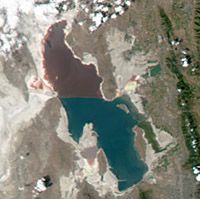My Cart
Your Shopping Cart is currently empty. Use Quick Order or Search to quickly add items to your order!
By Priya DasSarma
Center of Marine Biotechnology
University of Maryland Biotechnology Institute
Baltimore, MD

Imagine you are aboard the International Space Station, orbiting above earth. Looking down at the deserts of the western United States, you suddenly spot an unusual feature—a body of water that is half bright red and half ocean blue. You radio Mission Control and ask about this interesting sight. The controller tells you that one half of this lake, the Great Salt Lake, has the ionic composition of seawater and is blue. The other half, cut off almost completely by a causeway, is hypersaline and has turned red because of a bloom of tiny, halophilic (salt-loving) microbes. If only you could use those microbes in your classroom to engage your students’ imagination and initiative.
You can! The model microbe, Halobacterium sp. NRC-1, found in niches all over the world, including Utah’s Great Salt Lake, is one of the best-studied model microbes-certainly amongst the Archaea, the third domain of life. Studied for its tolerance of multiple environmental stressors, and for its potential applications in biotechnology, this nonpathogenic microbe is now available for use in your classroom and laboratory.
The hypersaline medium necessary for growing Halobacterium prevents contamination by most organisms (salt has long been used to preserve foods for the same reason). Because of this, students from middle school to college level can perform experiments without the concern of culturing pathogenic organisms, even if it is not possible to use strict sterile techniques (e.g., in the absence of Bunsen burners or experienced, practiced hands). In addition, the organism's 7-day culture period is great if you have a weekly lab schedule.
The educational use of Halobacterium has been demonstrated at numerous NSTA (National Science Teachers Association) meetings and at ASMCUE (American Society for Microbiology Conference for Undergraduate Educators). Student science fair projects using Halobacterium have won prizes in competitions nationwide. A dedicated Web site allows instructors and students to explore the wealth of information available about this versatile organism, facilitating the development of independent study projects and presentations.
Halobacterium is a beautiful microbe. It is even on display in a museum in Portugal as an example of ancient phototrophic, plantlike prehistoric organisms fossilized in stromatolites (fossilized microbial mats that contain a variety of microbes, including Cyanobacteria and halophiles). When grown in liquid culture, Halobacterium has a salmon pink appearance. When grown on plates, pink, red, and even sectored colonies are discernable. This phenotypic variation results from the organism's red pigments and its gas vesicles (which refract light, thus creating opacity). The gas vesicles allow the cells to float in liquid media.
When the genes involved in making these gas vesicles are disrupted or mutated, the cells lose their ability to produce the vesicles and the colonies appear red and translucent. The sectored colonies form when different daughter cells in a colony produce different numbers of gas vesicles. As the colony grows, these different-colored daughter cells give rise to different-colored sectors within the colony. The organism's beauty and its multiple, easily identifiable phenotypes provide students with both the incentive and material to perform experiments that can be used for independent research projects.
The DasSarma team is dedicated to making Halobacterium sp. NRC-1 accessible and user-friendly for classrooms and labs-in conjunction with Carolina it has created a line of kits using this interesting organism. All kits are designed to meet National Science Education Standards and to promote investigative, analytical, cognitive, and procedural skills. The first 2 kits, Basic Microbiology Skills Part 1 and Basic Microbiology Skills Part 2, were developed to provide secondary schools, colleges, and nursing schools with an alternative “introductory” microbe for teaching basic microbiology skills. These everyday, yet essential, lab skills include sterile technique, serial dilutions, plating, and streaking. The Extremely Easy DNA Extraction Kit allows students to perform an easy, rapid DNA extraction. It can also be used to introduce the concepts of DNA and the molecular basis of heredity.
The Introduction to Life in an Extreme Environment Kit was designed to introduce students to microbial diversity in the form of extremophiles (organisms that live in extreme environments) and Archaea. It facilitates teaching about the ability of microbes to survive harsh conditions such as desiccation. In addition to information on Halobacterium sp. NRC-1, the kit's manual provides general information about other microorganisms that live in extreme environments. This kit meets the following National Science Education Standards for life science, grades 5-8: populations and ecosystems, and diversity and adaptations of organisms.
Expanding into the medical arena, the latest kit, Antibiotics in Action, exposes students to the Kirby-Bauer test (a test for microbial antibiotic resistance) using a nonpathogenic microbe. The kit's manual also includes a thorough background on antibiotics.
In summary, Halobacterium sp. NRC-1 lends itself to making microbiology manageable and accessible to secondary schools and colleges nationwide, as well as to students interested in pursuing deeper interests in the field. The DasSarma team and Carolina have developed cultures and kits that greatly facilitate the use of this beautiful, fascinating halophile in classrooms and laboratories. These new resources now enable you to engage your students' imagination and initiative with Halobacterium sp. NRC-1.
DasSarma, S. 2006. Extreme halophiles are models for astrobiology. Microbe 1:120–127.
DasSarma, S., B. R. Berquist, J. A. Coker, P. DasSarma, and J. A. Müller. 2006. Post-genomics of the model haloarchaeon Halobacteriumsp. NRC-1. Saline Systems 2:3.
DasSarma, S., F. T. Robb, A. R. Place, K. R. Sowers, H. J. Schreier, and E. M. Fleischmann. 1995. Archaea: A Laboratory Manual—Halophiles. Cold Spring Harbor Laboratory Press, Cold Spring Harbor.
DasSarma, S. and P. DasSarma. 2006. Halophiles. In Encyclopedia of Life Sciences. John Wiley & Sons, Ltd., Chichester.